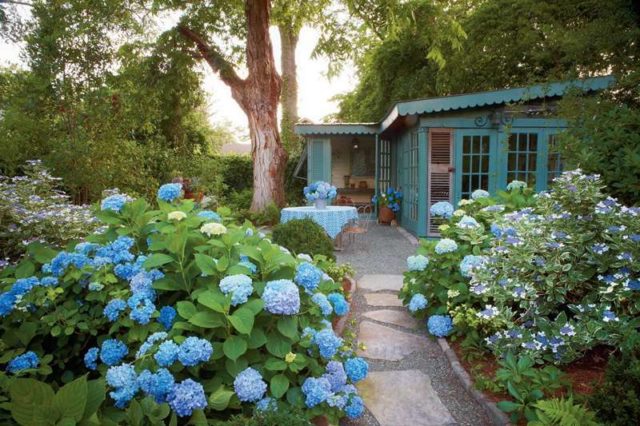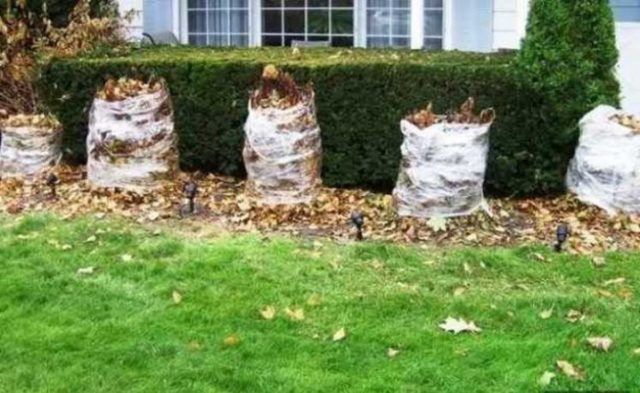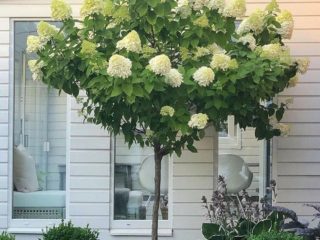Content
Blue hydrangea is a very beautiful ornamental plant with blue flowers. Growing a shrub in your garden is not difficult, but you need to know its characteristics and care rules.
Description of blue hydrangea
The plant from the Hydrangeaceae family is a large shrub, reaching 1 to 2 m in height. The shoots of the bush are covered with large bright green heart-shaped leaves; it blooms from early June until autumn in large hemispheres up to 25 cm in diameter.

The blue color of hydrangea flowers comes from the high acidity of the soil.
Blue hydrangea is not a separate plant variety. The color of the flowers depends on the characteristics of the soil, for example, on neutral soil the shrub produces white or beige flowers, on alkaline soil it produces pink and red inflorescences.The bluish color of the flowers of the shrub is given by oxidation of the soil - the trunk and shoots of the plant accumulate substances, due to which the flowers acquire a blue or light blue color.
Varieties of blue hydrangea with photos and names
Since not all hydrangeas are capable of producing blue flowers on acidic soils, it is customary to select individual varieties that change color more easily and most readily. Several species are popular with gardeners.
Blau Mays
Blue hydrangea can reach 1.5 m in height, and spherical inflorescences grow up to 25 cm in diameter. The plant changes the shade of its flowers depending on the soil - from sky blue to purple. The bushes grow quickly, so with the help of hydrangea you can transform your garden plot in a few seasons.

?Blau Mays - fast growing blue variety
Mini Penny
The light-loving plant has good disease resistance and is therefore very popular. The shrub reaches only about 0.5-1 m in height, its leaves are green, and the spherical inflorescences are blue in acidic or pink in alkaline soil. The shrub blooms from July to September and, due to its compact size, is actively used in group plantings.

Mini Penny - compact shrub with spherical blue inflorescences
Freedom
A short shrub up to 1.2 m in height prefers to grow on moist soils in shaded areas. Hydrangea has dark green leaves with jagged edges and bears inflorescences up to 15 cm in diameter.At the beginning of flowering, the color of the plant is white-pinkish, but in acidic soil it gradually turns blue. At the same time, some flowers can remain pink, which gives the shrub an even more interesting look.

Freedom - a tall variety with dark green foliage and blue inflorescences
Popcorn Blue
Popcorn hydrangea produces large, popcorn-shaped blooms that are bright blue or purple. The height of the shrub grows up to 1 m; the budding period lasts from July to September. Popcorn Blue prefers to grow in lighted areas and tolerates winter frosts well even without shelter.

Popcorn Blue - a blue variety with unusually shaped flowers
Ramars
This plant variety can produce blue-white or blue flowers, or violet and purple inflorescences, depending on the soil. The height of the bush usually does not exceed 0.8 m; Ramars prefers to grow in the shade and on well-moistened soils.

Ramars - variety with blue or purple blooms
Blue hydrangea in landscape design
Hydrangea is one of the most popular garden plants due to its decorative properties. Shrubs are used to decorate lawns, create group and single compositions, and plant the plant as a hedge.
It can be planted near the gate to the site, next to the gazebo in the garden or near the entrance to the house. The shrub goes well with perennial ornamental grasses. If you make it the center of an artistic composition, then such a flowerbed is guaranteed to attract glances.

With the help of plants, flower beds, hedges and artistic plantings are formed.
Frost resistance of blue hydrangea
Large-leaved blue hydrangea tolerates winter cold well.Most varieties can easily tolerate temperatures down to -30 °C; the decorative properties of shrubs do not suffer from this. True, with late frosts in the spring, flowering may be disrupted if part of the plant buds freezes.
You can grow blue hydrangea even in the Urals and Siberia, but you need to choose the most cold-resistant varieties. For example, the varieties Freedom and Ramars are distinguished by increased resistance to cold.

The plant tolerates winter cold well, in contrast to sharp autumn frosts.
Planting and caring for blue hydrangea
The care requirements of blue hydrangea are low; the hardy plant can be successfully grown both in the middle zone and in more severe regions. But the gardener needs to know some of the nuances responsible for the decorativeness of the plant.
Selection and preparation of a landing site
It is recommended to plant blue hydrangea in the spring, after the snow cover has melted and positive temperatures have established. Typically, the shrub prefers well-lit places with light shading, and it feels uncomfortable both in dense shade and in the sun. The optimal location for it is an area near a wall or a high fence, since the buildings can shade and at the same time protect from the wind

When preparing the site, it is important to qualitatively acidify the soil or reduce the pH level to 6
When growing blue hydrangea, special attention must be paid to the composition of the soil. The shade of the flowers directly depends on this moment. In general, hydrangea prefers nutritious soil consisting of fertile forest soil, humus, peat and sand.However, the acidity level of the soil is of great importance; it should be between 5.5 and 6 pH.
If the soil is not acidic enough, aluminum sulfate must be added to it. If the soil is too acidic, you can dilute it with dolomite flour, which will help achieve the optimal pH.
How to plant blue hydrangea
Planting blue garden hydrangea is carried out in almost the same way as planting an ordinary large-leaved hydrangea bush:
- A few days before planting, the plants dig a hole in the selected area, about 60 cm deep and 50 cm wide.
- Half of it is filled with prepared soil consisting of forest soil, peat and compost; sand is also added to the mixture; it will provide drainage and increase the looseness of the soil.
- Complex fertilizers are added to the hole, which will contribute to the rapid development of the bush; if necessary, aluminum sulfate or dolomite flour is also added to acidify or alkalize the soil, respectively.

The plant needs frequent watering
After this, the blue hydrangea seedling is lowered into the hole and the root system is straightened, and then the hole is completely filled with earth. The root collar of the plant should not be buried, otherwise the shrub will not grow well. The earth is lightly compacted so that it does not sag, and 2-3 buckets of water are poured under the bush. After this, the tree trunk circle is mulched with peat or wood chips to retain moisture.
Watering and fertilizing
Blue hydrangea grows quickly and loves moisture.Therefore, you need to water the bush twice or thrice a week if the weather is dry, and once a week if the summer is rainy. 3 buckets of water are poured under the bush, and the liquid should be warm, since cold water negatively affects the health of blue hydrangea.
It is necessary to feed the shrub three times during the growing season:
- The first feeding is carried out in May; during the next watering, granules of urea, superphosphate and potassium sulfide are dissolved in water.
- During the period of hydrangea budding, it is fed with superphosphate and potassium sulfur, also along with watering, so that the nutrients are quickly absorbed by the plant.
- At the end of summer, the bush is fertilized with organic matter, for example, compost or rotted manure.

It is not recommended to feed the plant with ash, it reduces the acidity of the soil.
Trimming
Without regular trimming, blue hydrangea bushes can grow very quickly and lose their decorative effect. In addition, if there is an excess of green mass, flowering will deteriorate; the plant will not have enough strength to form blue inflorescences.
The plant needs to be pruned in the spring, and the procedure looks like this:
- All old shoots that have lost their decorative effect are removed from the bush;
- cut off young shoots that disturb the harmony of the bush;
- shorten annual branches, but do not cut them off entirely, so as not to damage the flowering;
- trim the top of the bush and remove the remains of dried flowers.
Timely pruning helps protect blue hydrangea from pests and diseases and improves its immunity. In addition, after cutting, the plant begins to actively grow and forms young shoots that participate in flowering.
How to cover blue hydrangea for the winter
Varieties of blue hydrangea are predominantly large-leaved and tolerate winter cold well, but do not respond well to the first autumn frosts. Therefore, it is necessary to cover blue hydrangea, especially young ones, in advance, while the temperature is still at 6-8 °C.

For the winter you can build a frame shelter for the plant
Before wintering, the remaining foliage is removed from the hydrangea bush, leaving only the upper leaves located next to the buds to protect the buds from frost. After this, the tree trunk circle is carefully mulched with a dense layer of pine needles, peat or compost, and the bush itself is covered with agrofibre and covered with spruce branches.
An interesting option is to build a special frame around a plant bush for the winter. In this case, the hydrangea is covered with insulating material, then a high frame is installed around it, for example, a wooden box or metal mesh. Fallen dry leaves are poured inside the frame, and the blue hydrangea is reliably protected from the cold.
How to propagate blue hydrangea
There are several ways to increase the population of blue hydrangea in the garden:
- cuttings — young side shoots are cut at the beginning of summer, rooted in water or in a sand-peat mixture, grown indoors throughout the season, and transplanted into the ground the next year;
- dividing the bush - an adult hydrangea over 4 years old is carefully dug out of the ground and its rhizome is divided into pieces with a sharp shovel, after which the sections are planted in prepared areas;
- layering - at the end of spring or beginning of summer, you need to bend the strong lower shoot of the bush to the ground, slightly bury it in the ground in the middle part and fix it, and next year separate it from the mother bush.

The shrub reproduces well by dividing the rhizome, cuttings and layering
Seed propagation of shrubs is rarely practiced, since growing hydrangea from a seed is much more difficult than vegetatively. But if you want to carry out seed propagation, then planting material must be purchased in the store; seeds from garden bushes do not allow you to obtain a plant with varietal characteristics.
Diseases and pests
The plant has average disease resistance. If not cared for properly, blue hydrangea often suffers from fungal diseases and insects. Among the diseases that most often affect shrubs:
- Gray rot. With this disease, young shoots become covered with brown spots, the roots begin to rot, flowering stops, and the hydrangea gradually dies.
Gray rot primarily affects the roots, and then the leaves begin to wither.
- Powdery mildew. The fungus can be recognized by yellow-green or brown spots on the leaves and a grayish coating on the underside of the leaf.
Powdery mildew is easily recognized by its white coating
- Chlorosis. The disease develops due to a lack of iron in the soil, because of which the leaves of the bush become light green, and then turn yellow, growth slows down and flowering stops.
With chlorosis, the leaves of the plant turn yellow and lose strength.
The fight against ailments is carried out with the drugs Fundazol, Skor and Topaz. To save the damaged shrub, you need to remove all damaged shoots and inflorescences, spray, and then pay special attention to proper care.
Among the pests that are dangerous for blue hydrangea are:
- aphid - the microscopic pest multiplies very quickly and feeds on the foliage of the plant;
Aphids are one of the most dangerous pests for hydrangeas in the garden.
- spider mite — small insects eat hydrangea leaves and tighten the plant with a thin web;
The thin web left by the mite further interferes with photosynthesis and bush growth
- May beetles — beautiful insects can feed on hydrangea leaves, and their larvae eat the roots of the bush;
Despite its beautiful colors, the cockchafer is a garden pest.
- nematode worms - It is very difficult to notice the worms, and they cause damage to both the roots and the green parts of the bush.
Nematodes attack the roots and stems of blue hydrangea and are very difficult to treat
If the leaves of the plant, under the influence of pests, begin to curl and turn yellow, holes or light cobwebs appear on them, the bush begins to develop worse, it is necessary to spray with copper sulfate and Bordeaux mixture. The preparations Fitoverm, Iskra and others also have a good effect; in case of mild damage, the hydrangea can be sprayed with the usual infusion of onion peels.
Conclusion
Blue hydrangea is a beautiful shrub that comes in many varieties. To achieve blue or pale blue blooms, the gardener needs to choose the right varieties of hydrangea and monitor the acidity of the soil, then growing an unusual shrub will not be difficult.
















Good afternoon, in the photo with the note: “Despite the beautiful colors, the cockchafer is a garden pest.” A completely different and very useful beetle for the garden is presented. It's called Bronzovka. Please change the photo!
Hello Julia!! Many thanks for your attentiveness! Everything was replaced. Thank you!